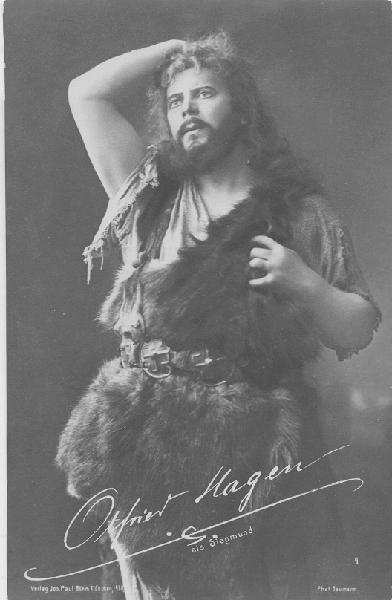Otfried Hagen
Otfried Hagen was born in Braunschweig in 1868. His real name was Kirchhoff. He was first a merchant. He started rather late to learn singing: at 26 years, he took lessons in Frankfurt with Franz Krückl, then in Hannover with Gustav Gunz. He made his debut in Heidelberg in 1897 and in 1898 sang in Altenburg, where he married the artistically gifted daughter of the painter Walter. A painter and a pianist, he studied his parts with Hagen, and designed his much-praised stage costumes. After being in Stettin, Hagen went to Magdeburg in 1900, where he was classified as a heldentenor. He made his debut there as Tannhäuser. In 1902, he moved to Freiburg. At that time his repertory comprised 32 parts. In 1906, he moved to Munich, where he could not get along with chief conductor Felix Mottl. During the yearly summer Wagner festival in Munich, he only got to sing Froh, so in 1909, he decided to move back to Braunschweig. In 1911, Braunschweig's theater director Julius von Wangenheim was replaced by Baron Egbert von Frankenberg und Ludwigsdorf, who promptly destroyed the opera house through mismanagement. Many soloist contracts were not renewed, also not Hagen's. Hagen moved to Frankfurt. The new Braunschweig director lasted two years. In 1913, he was replaced by the previous one. Hagen returned to Braunschweig in 1914. After that, he was in Mainz (1916), Würzburg (1917), and Metz (1918). He had to leave Metz after Germany had lost the war. Hagen sang one more year, and his last review (Tannhäuser) dates from September 1st, 1919 in Berlin. It was a failure. Hagen died in Frankfurt am Main on December 8th, 1923. Reference: Einhard Luther, So viel der Helden. Biographie eines Stimmfaches, Teil 3: Wagnertenöre der Kaiserzeit (1871–1918), Berlin 2006 |
